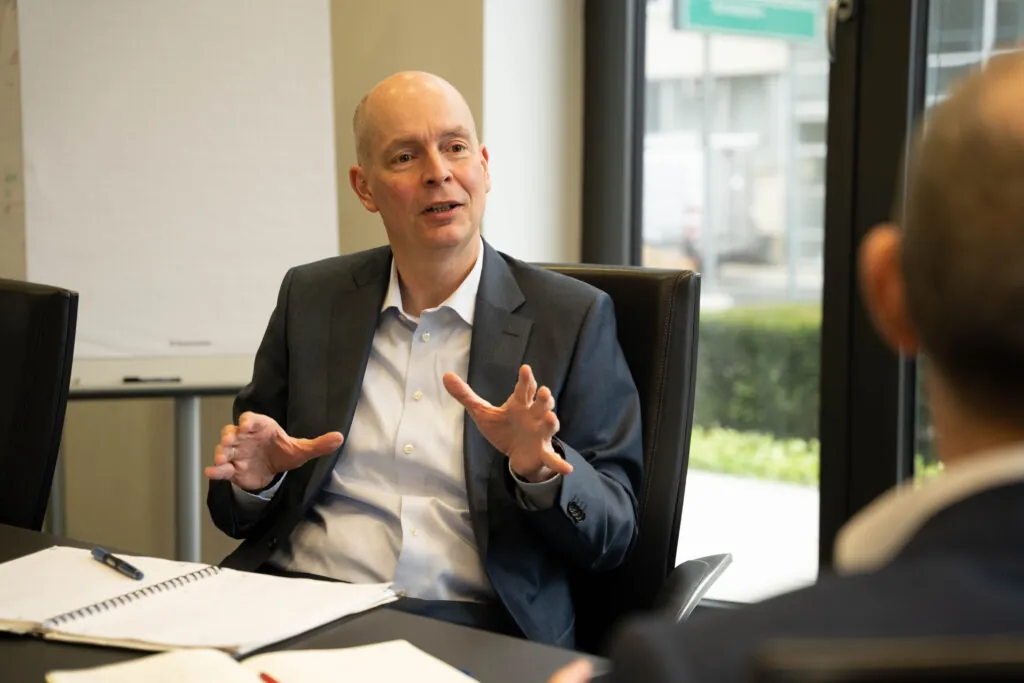
IT Organisation 2025

“Transformation: the why must be internalized”
The IT of the future will merge much more closely with the business, that is a fact that Dr. Markus Schlobohm states. In an interview with Thomas Heinevetter, Managing Director of kobaltblau Management Consultants GmbH, the Head of Information Technology at Techniker Krankenkasse explains the status quo of IT in the company and the way forward.
The IT of the future – Where is the trend heading?
Thomas Heinevetter: The IT of the future – presented in four scenarios: Scenario 1 – complete merger of business and IT with E2E product teams, Scenario 2 – strong merger division of IT into E2E product teams and IT as platform provider, Scenario 3 – partial merger, IT remains as an organization with virtual E2E product teams, Scenario 4: Hybrid IT, combination of virtual E2E product teams and “classic” plan-build-run teams. Where is the trend heading?
Dr. Markus Schlobohm: The trend is towards merging – in the sense of close collaboration in virtual teams. Although the specialist departments remain part of the core organization, they are involved in virtual teams, which are then given product responsibility and work with new tools, methods and framework conditions. However, there will still be a large proportion of cross-sectional IT teams for traditional IT operational issues. They ensure that the virtual teams can concentrate fully on the product. And not all legacy issues will have been resolved in five years’ time. My assessment: Scenario three already exists today for some areas, it can be fully achieved in three years – then scenario two will follow relatively quickly.
Heinevetter: So scenario three will be the transition scenario until the real dedicated merger?
Schlobohm: Even this merger will not mean that virtual teams are staffed exclusively by IT employees. Instead, there must be a contact person for the business side who can also think about the IT perspective. Merging means that everyone is responsible for one product.
Heinevetter: Can this approach be implemented in all areas of a company?
Schlobohm: Areas that are not directly related to the product will not be affected. These include overhead functions or products and services of an internal nature such as shared services. A complete integration of IT and business is not advisable here.
Heinevetter: What about HR or financial controlling, for example?
Schlobohm: Product teams can eliminate weaknesses here that have a negative impact on ‘time-to-market’ or customer satisfaction, for example. Product teams should generally be geared towards the product concept, rapid availability and customer needs.
Heinevetter: Tendencies such as citizen development or no-code or Low-code platforms increase IT affinity in specialist departments – and also shadow IT. What influence do they have on this cooperation model?
Schlobohm: From an IT perspective, strong governance is necessary. Then it should also be possible for the business side to use low-code platforms and the like. The crucial point is that this fusion actually goes both ways: IT no longer has to do everything itself, but it must not be left out either. This can be achieved with strongly anchored governance that takes all security and operational aspects into account, but requires a high level of maturity in the overall organization.
Heinevetter: The majority of all IT organizations are currently dealing with the topic of product orientation. The definition itself is difficult: What are the products?
Schlobohm: A shared understanding of ‘the product’ is crucial to success. There are the core products for end customers, but also additional products that are enriched with internal cross-sectional products in the sense of a platform economy. And it is also important to answer the question: What problem will be solved if we now work in a product-oriented way?
Heinevetter: What are the criteria for a successful product orientation or product-oriented teams?
Schlobohm: To enable product owners to focus on agile working in product development, it is necessary to establish a strategic framework. This includes the definition of a product vision to be developed jointly with the management or major goals at the strategic level. In addition, the PO must be appropriately legitimized to exercise this ownership. It is also important that virtual teams, which are then given final responsibility, have the necessary skills: Experts from IT development, design, business specialists through to UI or UX. And it should also be clear: If the entire company does not work in a product-oriented manner, but retains individual traditional line areas, this will lead to friction. A product development team will suddenly find itself in the annual planning process, in budget processes – i.e. legacy company processes.
Heinevetter: Let’s talk about the roles: Is the PO enough or are process specialists and classic administrators also needed in the product team on the specialist department side?
Schlobohm: They are represented in our product teams, which have an average of 15 employees. The clerk knows the customer side, and process specialists know the processes in specialist areas. Ideally, organizational links to test laboratories are also integrated in order to link the products directly to customer requirements.

Heinevetter: Do we still need the Demand Manager?
Schlobohm: The role of Demand Manager at TK is not tied to a person who is attached to a specific line unit, but represents an overarching, additional role. We also try out different variants here, e.g. two team leaders at TK also had demand management roles in addition to their project business.
Heinevetter: Who is responsible for the strategic product portfolio and management of TK?
Schlobohm: Most products revolve around supply. To this end, a separate governance system and committees have been established that keep an eye on the budget and portfolio and check whether they are up to date or in demand. Digital products from external providers are also checked to see whether they fit the company and are suitable for integration.
Heinevetter: How is the development of your own products organized?
Schlobohm: The products that we develop ourselves are created in an organizational structure with agile product development teams – with squads and associated tribes. Associated Tribe Lead and Chapter Lead functions are currently being docked onto the conventional organization. Here, too, there are committees that are currently starting their work: a board that reviews the demands and business owners who regularly review the overall portfolio and manage, prioritize, escalate, delete or add to it accordingly. The whole thing is a community task. There is no such thing as a ‘master product portfolio manager’.
Heinevetter: How does TC implement efficient resource management in virtual product teams?
Schlobohm: This is an issue that now requires a dedicated role. Because resources are scarce – in IT and in the specialist departments. UI, UX and other roles are also in short supply. Virtual teams now require comprehensive resource management and associated skills management.
Heinevetter: What experience have you gained on the way to squads, tribes and the separation of professional and disciplinary leadership?
Schlobohm: In some areas, there are pains of separation, they mourn the loss of product responsibility. However, there is also a need for action on the process and tool side. HR tools, employee evaluation and personnel development processes are still geared towards the traditional line. They must be adapted and the associated framework conditions changed.
Heinevetter: Another topic for many companies is data-driven. Does TK need a Chief Data Officer?
Schlobohm: Business and IT also need to work more closely together for a data-driven company. The reason: ‘data-driven’ is a rather abstract term – while the purpose of the product teams is tangible. In my view, this is why a special role such as that of the Chief Data Officer is needed: this person can act as a ‘sense maker’ and define the purpose. The CDO role may then lead to ‘data-driven virtual teams’ that know immediately what needs to be done thanks to comprehensive information.
Heinevetter: Is this the role of the CIO tomorrow?
Schlobohm: This is about a different form of data ownership. It’s about multi-layered information and its use. This is a role that does not necessarily have to come from IT.
Heinevetter: Would this role then have to be much more decentralized for each department?
Schlobohm: There will never be one ‘superhero’. It should be organized decentrally so that the department not only has ownership, but also recognizes the need to use the data for innovation. The CDO could ensure that appropriate structures are created.
Heinevetter: Where do you stand today in terms of data governance, processes and data science?
Schlobohm: The major challenges lie in the cooperation between decentralized data owners in the specialist departments with the central IT organization and a data lake governance organization. We are tackling these challenges as part of a project and want to unearth the treasure trove of data so that all areas can benefit from it.
Heinevetter: Who is the top project manager?
Schlobohm: It is a centralized project for which responsibility lies jointly at the divisional management level of Controlling, IT and the specialist side.
Heinevetter: What are the critical success factors in such a transformation?
Schlobohm: Transformation cannot really be planned. In my view, the story and the narrative behind it are critical to success. There must be an answer to the questions: Why are we doing this? What problem is being solved? What will be different afterwards? Everyone involved must have internalized the story. We also need to invest in employees. Budgets or resources are the lesser problem – mindset and culture have to be right. And staying power is needed to stay on the right course.
Heinevetter: What are your top 3 areas for action?
The focus is on DevOps. Suitable IT operating models are needed for the existing range of applications.
The second topic is the people business: we need new skills – also because the baby boomers will be leaving the company in a few years’ time. The area of leadership and further development of the ‘leadership muscles’ of IT managers is important here, so that they are fit, for example, for leading in agile structures.
The third topic on the list concerns ecosystems and the platform economy. The classic core products are to be more closely networked with third parties. This concerns topics such as the associated governance, authentication and what an IT service construct should look like in the digital age.

Dr. Markus Schlobohm
Dr. Markus Schlobohm has been CIO (Head of Information Technology) at Techniker Krankenkasse since October 2019. Prior to this, he was head of the Corporate Development division. Before joining the Techniker Krankenkasse, Dr. Schlobohm held various management positions in the Lufthansa Group, most recently as Managing Director of a Lufthansa subsidiary in the finance division. He studied mathematics and economics at the University of Kiel and holds a degree in mathematics.




